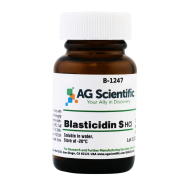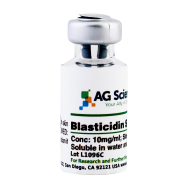Blasticidin S is an antibiotic used by scientists in bio-research to select cells modified by genetic engineering. It inhibits the growth of a wide range of prokaryotic and eukaryotic cells by interfering with protein synthesis. Blasticidin S allows the selection and maintenance of cells expressing the blasticidin-resistance gene.
What is Blasticidin S HCl?
Blasticidin S HCl (also known simply as Blasticidin S) is an aminoacyl nucleoside antibiotic isolated from Streptomyces griseochromogenes. It functions by inhibiting peptide bond formation at the ribosome in both eukaryotic and prokaryotic cells. It blocks hydrolysis of peptidyl-tRNA due to the large ribosomal subunit increased affinity for tRNA. The compound has two deaminase genes: BSD from Aspergillus terreus and bsr from Bacillus cereus, where resistance is shown converting it into a nontoxic deaminohydroxy derivative.
Applications
- Used as a selection agent for bis, bsr, or BSD resistance genes
- Prevents cell culture contamination
- Effective antiviral, anti-tumor, and anti-fungal properties
- New role in genome editing utilizing the CRISPR/Cas9 system
- Gene selection antibiotic
Mechanism of Action
Blasticidin prevents the expansion of each eukaryotic and prokaryotic cells.It works by inhibiting peptide bond formation by the ribosome. This means that cells will not create new proteins through translation of mRNA. The compound inhibits protein synthesis.
What is resistant to Blasticidin S Hydrochloride?
Three blasticidin resistance genes have been cloned and sequenced: an acetyl transferase gene, bls from a blasticidin producer strain, and two deaminase genes, resistance gene BSR from Bacillus cereus, and BSD gene from Aspergillus terreus. Both BSR and BSD genes are used as dominant selectable markers for gene transfer experiments in mammalian and plant cells. Although Blasticidin S was developed as a selection agent for mammalian cells, the BSR and BSD resistance genes can also be used in E. coli.
Can it be used with puromycin at the same time?
You may apply each selective agents at a similar time while not adverse result.Thus you can transfect cell lines with a blasticidin-resistance vector, while maintaining a puromycin selective pressure (to select for a previously introduced puromycin-resistant vector). It works also the other way around (blasticidin resistance vector first), or concomitantly (co-transfection of two vectors).
Blasticidin S HCl at AG Scientific, Inc.
Bulk & custom orders available! Shop now!
Product Specifications
| Chemical Formula: |
C17H26N8O5 • HCl |
| CAS Number: |
3513-03-9 |
| Molecular Weight: |
458.9 |
| Appearance: |
White powder |
| Purity: |
≥ 98.0% |
Solubility: The compound is soluble in water and insoluble in organic solvents.
Storage & Stability: When handling avoid contact with eyes, skin and clothing. Also avoid prolonged and repeated exposure. When storing at 4°C, keep it tightly closed. The product is stable under recommended storage conditions.
Recommended Concentrations for Usage with Mammalian Cells:
| Cell line |
Medium |
Blasticidin Conc. |
Ref. |
| CHO ( chinese hamster ovarian cells) |
DMEM |
5-10 ug/mL |
4.5 |
| HEK 293 ( Human embryonic kidney cells) |
DMEM |
5-15 ug/mL |
6.7 |
| HeLa ( Human uterine cells) |
DMEM |
2.5-10 ug/mL |
8.9 |
| Neuro2a (Mouse neuroblasts) |
DMEM |
30 ug/mL |
10 |
| THP-1 (HUman monocytes) |
RMPI |
10 ug/mL |
11 |
Scientific Citations Featuring AG Scientific's Blasticidin S HCl Products:
Additional Reading

